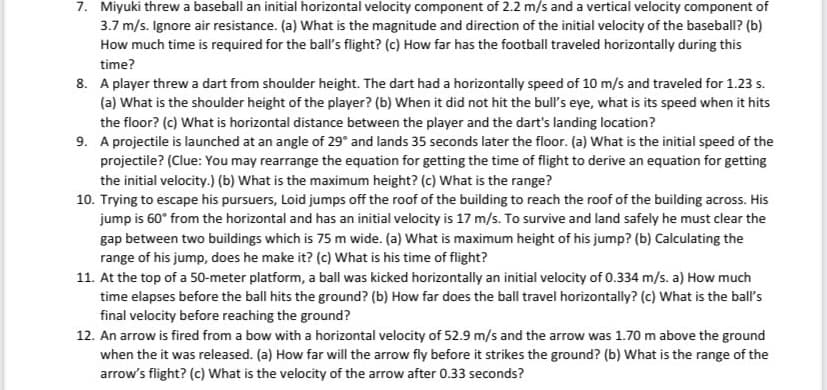Miyuki threw a baseball an initial horizontal velocity component of 2.2 m/s and a vertical velocity component of 3.7 m/s. Ignore air resistance. (a) What is the magnitude and direction of the initial velocity of the baseball? (b) How much time is required for the ball's flight? (c) How far has the football traveled horizontally during this time?
Miyuki threw a baseball an initial horizontal velocity component of 2.2 m/s and a vertical velocity component of 3.7 m/s. Ignore air resistance. (a) What is the magnitude and direction of the initial velocity of the baseball? (b) How much time is required for the ball's flight? (c) How far has the football traveled horizontally during this time?
Physics for Scientists and Engineers, Technology Update (No access codes included)
9th Edition
ISBN:9781305116399
Author:Raymond A. Serway, John W. Jewett
Publisher:Raymond A. Serway, John W. Jewett
Chapter4: Motion In Two Dimensions
Section: Chapter Questions
Problem 4.56AP: A ball is thrown with an initial speed i at an angle i with the horizontal. The horizontal range of...
Related questions
Concept explainers
Topic Video
Question

Transcribed Image Text:7. Miyuki threw a baseball an initial horizontal velocity component of 2.2 m/s and a vertical velocity component of
3.7 m/s. Ignore air resistance. (a) What is the magnitude and direction of the initial velocity of the baseball? (b)
How much time is required for the ball's flight? (c) How far has the football traveled horizontally during this
time?
8. A player threw a dart from shoulder height. The dart had a horizontally speed of 10 m/s and traveled for 1.23 s.
(a) What is the shoulder height of the player? (b) When it did not hit the bull's eye, what is its speed when it hits
the floor? (c) What is horizontal distance between the player and the dart's landing location?
9. A projectile is launched at an angle of 29° and lands 35 seconds later the floor. (a) What is the initial speed of the
projectile? (Clue: You may rearrange the equation for getting the time of flight to derive an equation for getting
the initial velocity.) (b) What is the maximum height? (c) What is the range?
10. Trying to escape his pursuers, Loid jumps off the roof of the building to reach the roof of the building across. His
jump is 60° from the horizontal and has an initial velocity is 17 m/s. To survive and land safely he must clear the
gap between two buildings which is 75 m wide. (a) What is maximum height of his jump? (b) Calculating the
range of his jump, does he make it? (c) What is his time of flight?
11. At the top of a 50-meter platform, a ball was kicked horizontally an initial velocity of 0.334 m/s. a) How much
time elapses before the ball hits the ground? (b) How far does the ball travel horizontally? (c) What is the ball's
final velocity before reaching the ground?
12. An arrow is fired from a bow with a horizontal velocity of 52.9 m/s and the arrow was 1.70 m above the ground
when the it was released. (a) How far will the arrow fly before it strikes the ground? (b) What is the range of the
arrow's flight? (c) What is the velocity of the arrow after 0.33 seconds?
Expert Solution
This question has been solved!
Explore an expertly crafted, step-by-step solution for a thorough understanding of key concepts.
Step by step
Solved in 2 steps with 1 images

Knowledge Booster
Learn more about
Need a deep-dive on the concept behind this application? Look no further. Learn more about this topic, physics and related others by exploring similar questions and additional content below.Recommended textbooks for you

Physics for Scientists and Engineers, Technology …
Physics
ISBN:
9781305116399
Author:
Raymond A. Serway, John W. Jewett
Publisher:
Cengage Learning

College Physics
Physics
ISBN:
9781285737027
Author:
Raymond A. Serway, Chris Vuille
Publisher:
Cengage Learning

Physics for Scientists and Engineers
Physics
ISBN:
9781337553278
Author:
Raymond A. Serway, John W. Jewett
Publisher:
Cengage Learning

Physics for Scientists and Engineers, Technology …
Physics
ISBN:
9781305116399
Author:
Raymond A. Serway, John W. Jewett
Publisher:
Cengage Learning

College Physics
Physics
ISBN:
9781285737027
Author:
Raymond A. Serway, Chris Vuille
Publisher:
Cengage Learning

Physics for Scientists and Engineers
Physics
ISBN:
9781337553278
Author:
Raymond A. Serway, John W. Jewett
Publisher:
Cengage Learning

Physics for Scientists and Engineers with Modern …
Physics
ISBN:
9781337553292
Author:
Raymond A. Serway, John W. Jewett
Publisher:
Cengage Learning

College Physics
Physics
ISBN:
9781305952300
Author:
Raymond A. Serway, Chris Vuille
Publisher:
Cengage Learning